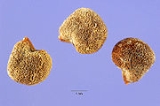
Anoda cristata
Encyclopedia
Anoda cristata is a species of flowering plant in the mallow family
known by many common names, including spurred anoda, crested anoda, and violettas. Its exact native range is unclear but it probably spans Mexico
and part or all of Central America
. It is known throughout the rest of the Americas as well as Australia
as an introduced species
and often a noxious weed. This is an annual herb reaching a maximum erect height between one half and one meter. The stem is ridged and branching. The plant is variable in morphology, especially in leaf shape, but leaves are usually somewhat triangular, and hairy. Solitary flowers grow in the leaf axils. The flower is 2 to 3 centimeters wide, with pointed green to reddish sepal
s and lavender petals. The fruit is a bristly, disc-shaped capsule with 9 to 20 segments. Each segment produces a seed. This is sometimes an agricultural weed
, especially of soybean
s. It is tolerated as a weed of crop fields in parts of Mexico, and even fostered, because it is eaten and used as a source of medicinal remedies.
Malvaceae
Malvaceae, or the mallow family, is a family of flowering plants containing over 200 genera with close to 2,300 species. Judd & al. Well known members of this family include okra, jute and cacao...
known by many common names, including spurred anoda, crested anoda, and violettas. Its exact native range is unclear but it probably spans Mexico
Mexico
The United Mexican States , commonly known as Mexico , is a federal constitutional republic in North America. It is bordered on the north by the United States; on the south and west by the Pacific Ocean; on the southeast by Guatemala, Belize, and the Caribbean Sea; and on the east by the Gulf of...
and part or all of Central America
Central America
Central America is the central geographic region of the Americas. It is the southernmost, isthmian portion of the North American continent, which connects with South America on the southeast. When considered part of the unified continental model, it is considered a subcontinent...
. It is known throughout the rest of the Americas as well as Australia
Australia
Australia , officially the Commonwealth of Australia, is a country in the Southern Hemisphere comprising the mainland of the Australian continent, the island of Tasmania, and numerous smaller islands in the Indian and Pacific Oceans. It is the world's sixth-largest country by total area...
as an introduced species
Introduced species
An introduced species — or neozoon, alien, exotic, non-indigenous, or non-native species, or simply an introduction, is a species living outside its indigenous or native distributional range, and has arrived in an ecosystem or plant community by human activity, either deliberate or accidental...
and often a noxious weed. This is an annual herb reaching a maximum erect height between one half and one meter. The stem is ridged and branching. The plant is variable in morphology, especially in leaf shape, but leaves are usually somewhat triangular, and hairy. Solitary flowers grow in the leaf axils. The flower is 2 to 3 centimeters wide, with pointed green to reddish sepal
Sepal
A sepal is a part of the flower of angiosperms . Collectively the sepals form the calyx, which is the outermost whorl of parts that form a flower. Usually green, sepals have the typical function of protecting the petals when the flower is in bud...
s and lavender petals. The fruit is a bristly, disc-shaped capsule with 9 to 20 segments. Each segment produces a seed. This is sometimes an agricultural weed
Agriculture
Agriculture is the cultivation of animals, plants, fungi and other life forms for food, fiber, and other products used to sustain life. Agriculture was the key implement in the rise of sedentary human civilization, whereby farming of domesticated species created food surpluses that nurtured the...
, especially of soybean
Soybean
The soybean or soya bean is a species of legume native to East Asia, widely grown for its edible bean which has numerous uses...
s. It is tolerated as a weed of crop fields in parts of Mexico, and even fostered, because it is eaten and used as a source of medicinal remedies.

